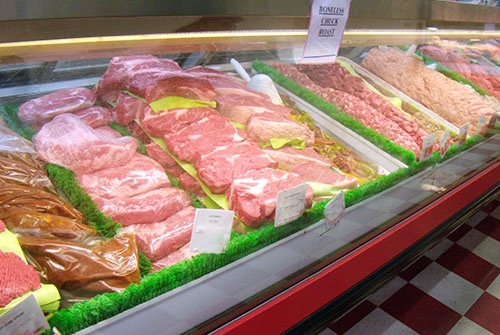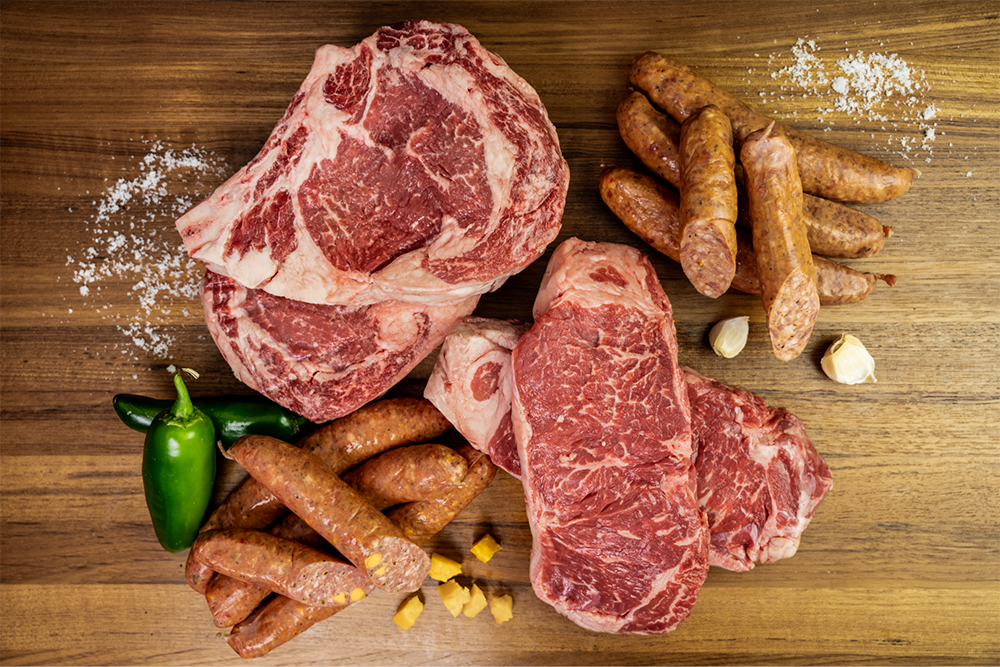Check Out Bagley Farms Meat Market Edwardsville IL for Farm-Fresh Meat and Specialty Cuts
Check Out Bagley Farms Meat Market Edwardsville IL for Farm-Fresh Meat and Specialty Cuts
Blog Article
Uncover the Art of the Butcher's Cut in a Modern Meat Market
In the ever-evolving landscape of modern-day meat markets, the butcher's cut has actually transcended its traditional origins, combining olden craftsmanship with contemporary practices. Today's butchers are not merely cpus of meat; they are educated craftsmens who highlight sustainability and honest sourcing. Their know-how in picking and preparing cuts tailored to specific cooking requirements uses an unmatched eating experience. What truly establishes the contemporary butcher apart is their capability to forge a much deeper link between customers and the origins of their meat. How do these masters equilibrium custom with development, and what implications does this have for the future of meat intake?
Evolution of Butchery Strategies
The development of butchery strategies shows an abundant tapestry of development and adjustment driven by developments in innovation, modifications in customer demand, and a much deeper understanding of meat science. Historically, butchery was a craft passed down via generations, with methods refined over centuries to take full advantage of return and taste. Nonetheless, the commercial revolution introduced mechanization, changing traditional methods and making it possible for large-scale processing.
The mid-20th century saw butchery methods better refined by scientific understandings right into muscle biology and meat aging, improving both inflammation and preference. Technologies like vacuum packaging and refrigeration expanded item shelf-life, permitting butchers to diversify offerings and improve quality assurance. This duration likewise noted the increase of specific tools, such as band saws and meat slicers, which raised accuracy and efficiency in meat processing.

The 21st century has actually presented electronic modern technology right into the butchery world. Digital systems currently help in tracking animal provenance and optimizing cuts to meet particular customer choices. In addition, a rebirth in artisanal butchery has actually emerged, blending traditional skills with modern expertise to provide to consumers seeking ethical and lasting meat choices. This development highlights a dynamic interaction in between custom and development, conference modern demands while protecting the craft's heritage.
Understanding Meat Cuts
Understanding the intricacies of meat cuts is crucial for both butchers and customers looking for high quality and value. For butchers, specific cuts reflect ability and regard for the craft, ensuring minimal waste and ideal return.

Recognizing muscle mass structure is crucial; muscle mass used more regularly by the animal often tend to be harder and are best suited for slow-moving cooking techniques, while less-used muscles, like those located in the loin, are a lot more tender and suitable you can find out more for grilling or roasting. Knowledge with these distinctions encourages consumers to make educated choices, boosting their culinary undertakings.
Choosing Quality Meat
Choosing the ideal meat entails greater than just choosing a visually attractive item from the screen. bagley farms meat market edwardsville il. The art of choosing top quality meat needs a discerning eye and understanding of certain qualities that represent freshness and excellence. First of all, take note of the color; beef must have an intense, cherry-red hue, while lamb should display a soft pink tone, and pork a light pink. This shows the meat is fresh and hasn't been exposed to oxygen for also lengthy.
Second of all, take into consideration the marbling, which describes the white streaks of fat within the muscle. Correct marbling is an essential sign of tenderness and taste, as it melts throughout food preparation, boosting the meat's juiciness. Remember, greater marbling frequently associates with premium quality cuts, such as USDA Prime.
Appearance is an additional critical variable; meat must feel firm to the touch, not slimy or overly soft. In addition, bear in mind the fragrance. Fresh meat needs to have a clean, neutral smell, cost-free from any sour or repulsive smells.
Coupling Cuts With Food Preparation Approaches

Alternatively, tougher cuts like brisket and chuck roast are rich in collagen, which breaks down into gelatin when cooked gradually. These cuts are excellent for braising or slow roasting, permitting the meat to tenderize with time and create deep, intricate flavors. In a similar way, cuts such as brief ribs and pork shoulder make out well with slow-cooking methods, where prolonged cooking times change their robust appearances into delicious meals.
Lamb shanks and oxtail, which call for extended cooking to soften, are excellent prospects for stewing or sluggish simmering. These techniques coax out rich, hearty tastes while keeping wetness. By recognizing the unique attributes of each cut, cooks and home chefs alike can elevate their culinary productions, making sure each dish is both pleasing and remarkable.
The Butcher's Function Today
Browsing the progressing landscape of the modern-day meat market, the butcher's function today extends past simple preparation of cuts. Contemporary butchers are culinary craftsmens, instructors, and supporters for sustainable practices.
In enhancement to crafting specific cuts, butchers now engage directly with consumers, providing cooking guidance and customizing options to match individual needs and preferences. Their expertise in meat aging, marbling, and taste accounts equips customers to make educated choices, improving their cooking experiences. This tailored service exhibits the butcher's evolving duty as a relied on consultant in the cooking area.
Furthermore, butchers are essential in reducing waste, using whole pets to create varied items such as sausages and supplies. This comprehensive approach not only respects the pet however additionally aligns with contemporary sustainability objectives. In this means, the modern-day butcher personifies both tradition and technology, adapting to an ever-changing market while maintaining the artistry and integrity of their craft.
Verdict
The modern butcher's craft delicately weaves traditional strategies with contemporary innovations, stressing sustainable techniques and ethical sourcing. Mastery in understanding diverse meat cuts and quality indications encourages butchers to provide enlightened referrals, straightening details cuts with ideal cooking methods. This competence not only elevates cooking experiences yet additionally reinforces the link between customers and the origins of their food. By recognizing historic techniques while accepting modern needs, the butcher's role continues to be essential in today's innovative meat market (bagley farms meat market edwardsville il).
Report this page